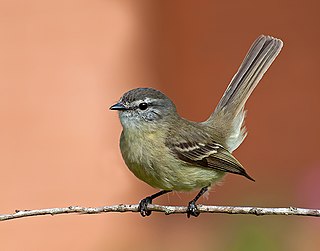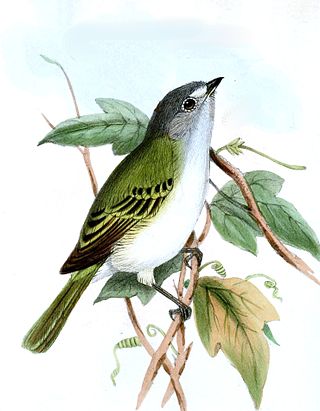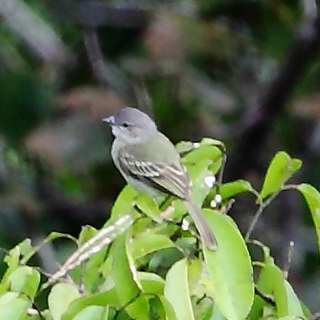
The buff-banded tyrannulet is a species of bird in subfamily Elaeniinae of family Tyrannidae, the tyrant flycatchers. It is found in Argentina, Bolivia, and Peru.

The white-tailed tyrannulet is a species of bird in subfamily Elaeniinae of family Tyrannidae, the tyrant flycatchers. It is found in Colombia, Ecuador, and Peru.

The white-banded tyrannulet is a species of bird in subfamily Elaeniinae of family Tyrannidae, the tyrant flycatchers. It is found in Bolivia, Colombia, Ecuador, Peru, and Venezuela.

The white-lored tyrannulet is a species of bird in subfamily Elaeniinae of family Tyrannidae, the tyrant flycatchers. It is found in Bolivia, Brazil, Colombia, Ecuador, French Guiana, Guyana, Peru, Suriname, and Venezuela.

The planalto tyrannulet is a species of bird in subfamily Elaeniinae of family Tyrannidae, the tyrant flycatchers. It is found in Argentina, Bolivia, Brazil, and Paraguay.

The grey-capped tyrannulet is a Near Threatened species of bird in subfamily Elaeniinae of family Tyrannidae, the tyrant flycatchers. It is endemic to Brazil.

Reiser's tyrannulet is a species of bird in subfamily Elaeniinae of family Tyrannidae, the tyrant flycatchers. It is found in Brazil and Paraguay.

Sclater's tyrannulet is a species of bird in subfamily Elaeniinae of family Tyrannidae, the tyrant flycatchers. It is found in Argentina, Bolivia, and Peru.

Urich's tyrannulet is an Endangered species of bird in subfamily Elaeniinae of family Tyrannidae, the tyrant flycatchers. It is endemic to Venezuela.

The greenish tyrannulet is a species of bird in subfamily Elaeniinae of family Tyrannidae, the tyrant flycatchers. It is found in Argentina, Brazil, Paraguay, and Uruguay.

Phylloscartes is a genus of small birds in the family Tyrannidae. They are found in wooded habitats of Central and South America. They mainly feed on small arthropods, and most commonly take part in mixed species flocks. The mottled-cheeked tyrannulet is among the commonest birds in its range, but several other species are rare and threatened. Their plumage is predominantly green, yellow, white and grey, and many have contrasting facial patterns and wing-bars. They have thin, pointed bills, and relatively long tails. Most frequently cock their tail, perch relatively horizontally and are very active.

The Serra do Mar bristle tyrant, or Serra do Mar tyrannulet, is a small species of bird in the tyrant flycatcher family Tyrannidae. It is endemic to Brazil.

The Sao Paulo bristle tyrant, or Sao Paulo tyrannulet, is a Near Threatened species of bird in the tyrant flycatcher family Tyrannidae. It is found in Argentina, Brazil, and Paraguay.

The Venezuelan bristle tyrant is a Near Threatened species of passerine bird in the family Tyrannidae, the tyrant flycatchers. It is endemic to Venezuela.

The mottle-cheeked tyrannulet is a generally common, small species of bird in the family Tyrannidae, the tyrant flycatchers. It is found in Argentina, Bolivia, Brazil, Paraguay, Peru, and Uruguay.

The Bolivian tyrannulet is a species of bird in the family Tyrannidae, the tyrant flycatchers. It is found in Bolivia and Peru.

The slender-footed tyrannulet is a species of bird in the family Tyrannidae, the tyrant flycatchers. It is found in Bolivia, Brazil, Colombia, Ecuador, Peru, and Venezuela.

The Yungas tyrannulet is a Vulnerable species of bird in subfamily Elaeniinae of family Tyrannidae, the tyrant flycatchers. It is found in Bolivia and Peru.

The Guianan tyrannulet is a species of bird in the family Tyrannidae, the tyrant flycatchers. It is found in Brazil, French Guiana, Guyana, Suriname, and Venezuela.

Coopmans's tyrannulet is a species of bird in the family Tyrannidae, the tyrant flycatchers. It is found in Colombia and Venezuela.






















